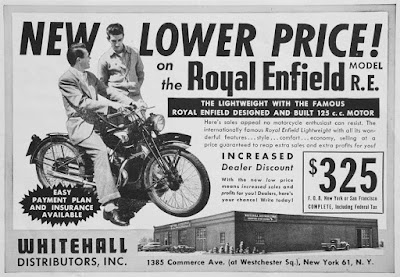The Royal Enfield RB125 "Royal Baby" motorcycle was designed for customers in the Netherlands. But the outbreak of World War II ended sales there almost before they could begin.
The Royal Baby, built in England, was a defiant copy of the DKW RT98, which the Germans had snatched away from Dutch importer R.S. Stokvis & Zonen before the war.
Records are sketchy, but Graham Scarth, chairman of the Royal Enfield Owners Club UK, tells me that approximately 120 Royal Babies are recorded as going to Stokvis in Rotterdam in July/August 1939. The club has the factory records.
During the war, Royal Enfield would make the little two-stroke lightweight motorcycle for the British military. It became the famous WD/RE "Flying Flea," dropped by parachute and glider for British airborne forces.
It served in plain brown paint, with its brake pedal now on the left, rather than the right, to suit the British.
But while the motorcycle was being produced in Britain, its Dutch designer remained in the Netherlands, a neutral nation invaded and occupied by the German army on May 10, 1940.
 |
| Joop Van Heusden. |
He always shared credit for creation of the Royal Baby with head mechanic R. de Vries and his staff at Stokvis. But there's no doubt Joop's own concept of the "ideal" lightweight motorcycle had shaped its design, making it even better in his mind than the DKW original.
Separated from his Royal Baby, he found himself with uninspiring work to do on gas generators — devices that substitute wood for scarce petrol. He had his books, his collection of gramophone records, and his dog Peter.
He chose to funnel his energy into helping motorcyclists, through lectures and columns in the Dutch magazine, "Motor." To readers he was "Motor Joop," full of advice and humorous stories. Photos show him lecturing, and surrounded by enthusiasts with technical questions.
Others on the magazine regarded him as honest, highly critical, and something of a grouch, but with the delightful ability to make fun of himself. He was also stubborn and outspoken — dangerous in an occupied country.
A German bullet ended his life. Coming back from grass track races on Oct. 31, 1943, he ignored a red light flashed at him from a car in the dark — probably a command to stop. He was shot in the neck. He's said to have given instructions on how to stop the bleeding.
He died of the wound the next day. He was 35 years old.
 |
| The number of crates lined up at the Royal Enfield factory in Edinburgh suggests the British were serious about air-dropping the Flying Flea. |
Dubbed the WD/RE, numbers of the Flying Flea were ordered for the British army in 1943. British Airborne forces had a busy war, with major drops during D-Day and the Operation Market Garden assault on the Netherlands. Without its cage the Flying Flea also fit neatly into assault gliders or beach landing craft.
Here is a video of a wartime WD/RE being ridden.
After the war the WD/RE became the civilian Model RE. It was popular.
"Just over 30,500 Model RE's were manufactured with the pressed steel girder forks and rubber band suspension between 1939-1949," Graham wrote. "This figure includes all the WD machines, as well as those produced for the Dutch importer before the war that were badged RB and called Royal Baby."
 |
| Americans got their chance to buy Royal Enfield's baby motorcycle after the war. Starting in 1955, later versions were even sold here badged as the Indian Lance. |
The Royal Enfield design would compete in the postwar world against many knock-offs of the original DKW, including the Harley Hummer, BSA Bantam, and others from the Soviet Union and Japan. Thanks to Joop Van Heusden and Royal Enfield, it was certainly the earliest and most unique of them.
In Britain, improved versions called Ensign and Prince remained in the Royal Enfield catalog into the 1960s.
Joop would not have recognized these later motorcycles, which had telescopic front forks, swinging-arm rear suspension, full-size tank, foot shift, electric horn, dual seating and even their own version of the Royal Enfield Airflow fairing.
In his book "Royal Enfield, The Postwar Models," author Roy Bacon would write that even these fancier versions eventually couldn't compete with popular four-stroke, 250cc machines coming on the market:
"...in August, 1962, the model left the range, and so brought to an end a machine run of over 20 years that had begun with a German foible and Dutch determination."
Part 1: The heroic Dutch man behind the Flying Flea.
Part 2: Flying Flea was his Royal Baby.























I've learned a lot, thanks!
ReplyDelete